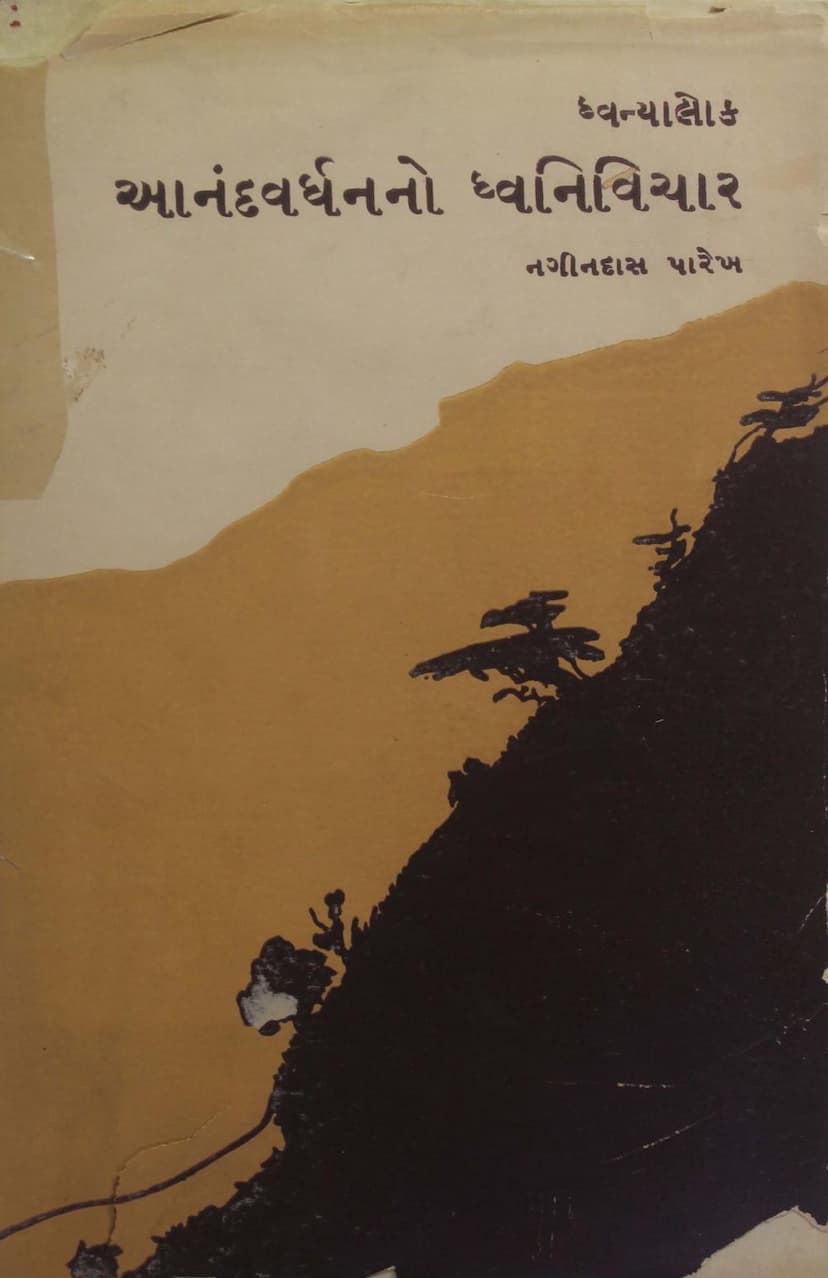Anandvardhanno Dhvani Vichar
Added to library: September 1, 2025

Summary
Here's a comprehensive summary of Nagindas Parekh's "Dhvanyalok: Anandavardhanno Dhvanivichar" based on the provided text:
Book Title: Dhvanyalok: Anandavardhanno Dhvanivichar (Dhvanyal alok: The Dhvani Theory of Anandavardhana) Author: Nagindas Parekh Publisher: Gujarati Sahitya Parishad, Ahmedabad Focus: This book is a Gujarati explanation and commentary on Anandavardhana's seminal work on poetics, the Dhvanyaloka.
Core Argument of Anandavardhana's Dhvanyaloka (as explained in the book):
The book focuses on explaining Anandavardhana's groundbreaking theory of Dhvani (suggested meaning or resonance) in Indian poetics. Anandavardhana posited that the true essence and soul of poetry lies not just in the literal meaning of words (Vachya) or secondary implied meanings (Lakshyartha), but in a deeper, suggested meaning called Dhvani. This Dhvani is what evokes emotion (Rasa) in the reader and is considered the highest achievement of poetry.
Key Concepts and Structure of the Book:
-
Anandavardhana's Contribution: The book highlights Anandavardhana's crucial role in establishing Dhvani as the central element of poetry, placing Rasa (aesthetic emotion) at its core and creating a cohesive system for understanding all aspects of poetry. This system became the standard for subsequent Indian literary theorists.
-
The Dhvanyaloka:
- Structure: The original text consists of Karikas (verses) and Vritti (commentary). The book notes the scholarly debate on whether both parts were written by the same author. However, for the purpose of explanation, it assumes a unified authorship.
- Approach: Parekh's book aims to explain the Dhvani theory based on the Dhvanyaloka. Where the commentary primarily restates the Karika or offers minimal explanation, the book integrates the commentary's meaning into the explanation of the Karika.
- Reliance on Abhinavagupta: The book primarily uses Abhinavagupta's commentary, Locana, which is considered as significant and expansive as his commentary on Natya Shastra (Abhinavabharati). While Locana is the primary source, not all its points are included, focusing instead on clarity of Anandavardhana's core ideas.
-
Historical Context of Indian Poetics: The introductory chapters (pages 10-12) provide a valuable overview of the development of Indian poetics before Anandavardhana, discussing the contributions of earlier theorists like Bhamaha, Dandin, and Vamana.
- Bhamaha & Dandin: Emphasized Alankara (figures of speech) as essential for poetic beauty and excellence.
- Vamana: Identified Riti (style) as the soul of poetry, defining it as a "distinctive arrangement of words." He categorized Riti into Vaidarbhi, Gaudiya, and Panchali, linking them to various poetic qualities (Gunas).
- Bharata Muni: His Natya Shastra focused on Rasa (aesthetic emotion) primarily in the context of drama, though Rasa was first mentioned in Panini's grammar and elaborated upon in Patanjali's Mahabhashya.
-
The Primacy of Rasa and the Introduction of Dhvani: While earlier theorists acknowledged Rasa, Anandavardhana elevated it to the supreme position. He recognized the limitations of Abhidha (literal meaning) and Lakhana (implied meaning) in capturing the full essence of poetry, thus introducing Vyanjana (suggestion) as the third power of language, which reveals Dhvani. Dhvani conveys the implied meaning that is central to poetry's appeal and is the true "soul" of the poem.
-
The Three Types of Dhvani: The book explains Anandavardhana's classification of Dhvani into three main categories:
- Vastu Dhvani: Suggested meaning related to objects or facts.
- Alankara Dhvani: Suggested meaning related to figures of speech.
- Rasa Dhvani: Suggested meaning related to aesthetic emotions, considered the highest form.
-
Critique of Opposing Views: Anandavardhana, as presented in the book, systematically refutes various schools of thought that denied or subsumed Dhvani within other concepts:
- Abhavavadins (Nihilists): Those who denied the existence of Dhvani.
- Lakshanavadins: Those who believed Dhvani could be explained through Lakshana (metaphor or secondary implication).
- Anirvachaniyatavadin: Those who considered Dhvani to be indefinable or beyond speech.
-
Methodology and Presentation:
- Clarity: Parekh's primary goal is to make Anandavardhana's complex theories accessible to Gujarati readers. He strives for clarity in explaining each concept.
- Subheadings: The book uses numerous subheadings throughout the text to break down the material, aiding readers in understanding the structure and main points of each chapter (Udyota). This is particularly helpful given the original text's continuous flow.
- Detailed Index: A detailed index (Vishayanukramanika) is provided to help readers navigate the content efficiently.
- Accessible Language: Parekh's writing style is described as that of a skilled teacher, explaining difficult concepts patiently and thoroughly in simple Gujarati.
- Use of Examples: The book utilizes numerous examples, both from Sanskrit classics and potentially other sources, to illustrate the abstract concepts of Dhvani and its related theories.
-
Author's Intent and Acknowledgements: Parekh states his intention was to provide a translation and explanation that students could understand independently. He expresses gratitude to various scholars and institutions, including Gujarat University and the Gujarati Sahitya Parishad, for their support. He also acknowledges the help received from English, Hindi, and Bengali translations of Dhvanyaloka.
Overall Significance of the Book:
"Dhvanyalok: Anandavardhanno Dhvanivichar" serves as a vital bridge, making a cornerstone of Indian literary theory accessible to a Gujarati audience. Nagindas Parekh's meticulous explanation and structured approach ensure that Anandavardhana's profound insights into the suggestive power of poetry are understood and appreciated. The book is deemed essential for students and scholars of Indian poetics.